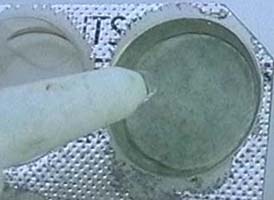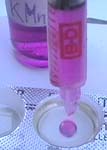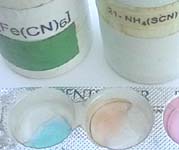 .......
....... ........
........
Me14 Reactions of iron(II)- and iron(III) salts from the electrolysis
 .......
....... ........
........
In the previous experiment
with the closure of a Cola can as cathode and a piece of its sandpapered
tin (Fe) as anode the insoluble salt iron(II) hydroxide
[Fe(OH)2(s)] was obtained in a redox reaction.
What
you need:
The blister with the iron(II) hydroxide of
the previous experiment, dropper bottles with
diluted solutions of potassium permanganate, sulfuric acid, potassium hexacyanate(II),
ammonium thiocyanate.
Left:
Add drops of sulfuric acid. * Stirr. Observation:
1.
The precipitation dissolves.
Middle:
Add 2 drops of this solution into blister 2. * Add drops of potassium permanganate.
* Stirr.
Repeat
adding and stirring until the colour of KMnO4-Lösung does
not longer diappear. Repeat in blister 1.
Observation:
2.
The
violet colour of KMnO4-solution
disappears. After a certain volume has been
added the colour remains (right blister in right photo).
Right:
Distribute the solution in blister 2 into two other blisters. 3.
Add
a drop of K4[Fe(CN)6] solution (left blister) and
4. a drop of NH4(SCN)
solution (blister in the mioddle).
Observation:
3.
blue
colour
4. red orange colour.
Explanations
1. "Dissolving":
Fe(OH)2(s)
+ H2SO4(aq) --acid base
reaction-----> Fe2+(aq) + (SO4)2-(aq)
+ 2 H2O
2. Disappearing
of colour: 5 Fe2+(aq)
+ [MnO4]- (aq) + 8H+(aq) -- redox
reaction-----> 5 Fe3+(aq) + Mn2++ 8 H2O
The iron(II)
ions are reduced leaving iron(III) ions, the violet permanganate ions are
reduced, Mn2+ ions being formed.
3. Blue
colour of the iron(III) indicatorpotassium
hexacyanoferrate-II:
K+(aq)
+ Fe3+(aq) + [Fe(CN)6]4-(aq)--->KFe[Fe(CN)6](s)
+ 3 (aq)
4. Orange
colour of the iron(III) indicator ammonium
thiocyanate:
Fe3+(aq)
+ 3 [SCN]-(aq)--->Fe[SCN]3